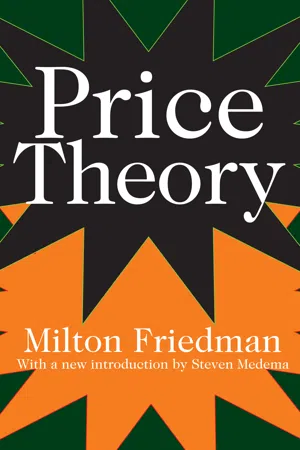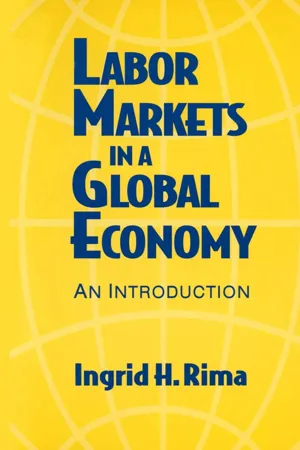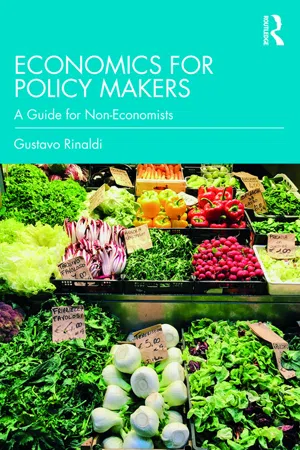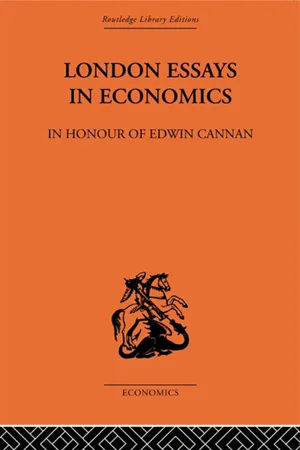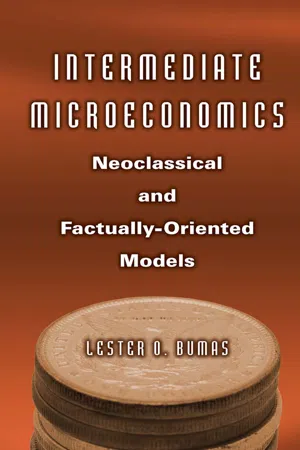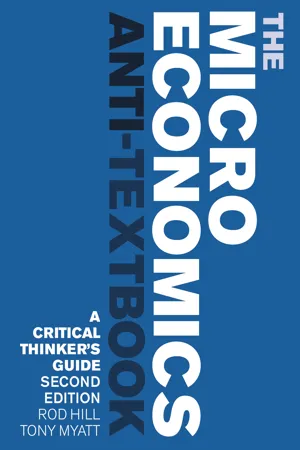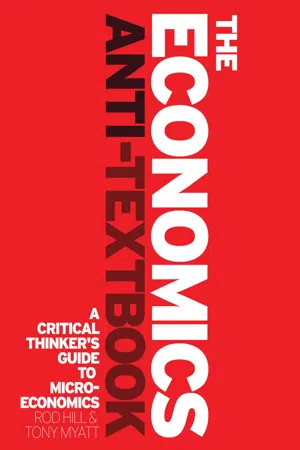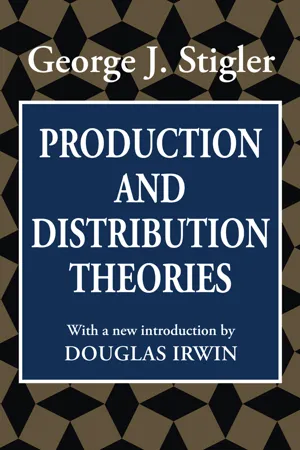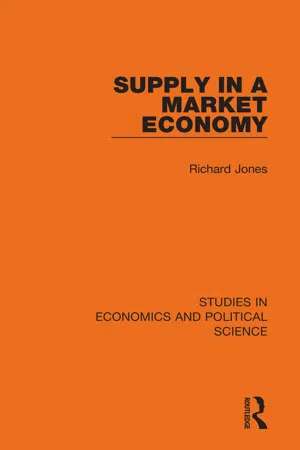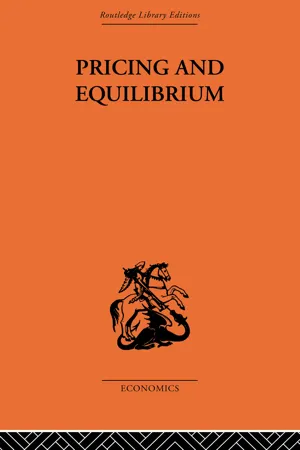Economics
Marginal Productivity Theory
The Marginal Productivity Theory states that the value of a factor of production is determined by its marginal productivity, or the additional output produced by adding one more unit of that factor. In other words, the theory suggests that the price of a factor of production, such as labor, should be equal to the value of the additional output it produces.
Written by Perlego with AI-assistance
Related key terms
Related key terms
1 of 4
Related key terms
1 of 3
11 Key excerpts on "Marginal Productivity Theory"
- eBook - ePub
- Milton Friedman(Author)
- 2017(Publication Date)
- Routledge(Publisher)
marginal productivity ) determine price. But note that even in this case a change in supply—in the fixed amount of a factor—will change the price of the factor, unless demand is perfectly elastic. So it will be better in all cases to regard the theory of marginal productivity as a theory solely of the demand for factors of production. A complete theory requires a theory of both the demand for and the supply of factors of production.In the main, the Marginal Productivity Theory is a way of organizing the considerations that are relevant to the demand for a factor of production. It has some, but not very much, substantive content. This is reflected in our ability to speak of an abstract factor of production—factors A or B, etc.—without having to specify it any further. To say that wages are equal to the value of the marginal product, for example, says relatively little in and of itself. Its function is rather to suggest what to look for in further analysis. The value of the marginal product is not a single number determined by forces outside the control of individuals or society; it is rather a schedule or function of many variables. It will depend on the quality and quantity of workers, the quantity of capital they have to work with, the quality of the management organizing their activities, the institutional structure of the markets in which they are hired and the product sold, etc. In concrete applications, the basic substantive issue is likely to be what determines the marginal productivity and how the changes under consideration will affect it.The analysis of the demand for factors of production is closely related to the analysis of the supply of products, and, indeed, is really only another way of looking at or organizing the same material. In analyzing the supply curve of a product, we are interested in tracing the effect of changes in the demand for it under given conditions on the factor markets. In consequence, we direct attention to the output of the firm or industry and take for granted the changes in the quantity of the various factors of production employed and in their prices as demand for the product and with it output of the product change. In distribution theory, our interest centers in the factor markets, and so we concentrate attention on a different facet of the same adjustment by the firm. To put it differently, the statement that a firm seeks to equate marginal factor cost to marginal value product is another way of saying that it seeks to equate marginal revenue to marginal cost rather than an additional condition on the equilibrium of the firm. - eBook - ePub
Labor Markets in a Global Economy: A Macroeconomic Perspective
A Macroeconomic Perspective
- Ingrid H. Rima(Author)
- 2015(Publication Date)
- Routledge(Publisher)
The marginal productivity principle is central to such behavior on the demand side of the factor market. This is, however, not a universal principle of employer behavior, even though its validity is ingrained in the conventional wisdom as a basis for understanding how employment decisions are made in advanced capitalistic economies such as the United States. It is, in fact, a principle that has only limited real-world relevance because production functions in the core are increasingly characterized by fixed rather than variable proportions, either for engineering reasons or in consequence of workplace rules. When proportions are fixed, the marginal productivity of a factor is indeterminate. Nevertheless, the conditions under which the marginal productivity principle does apply are important in their own right, and they continue to be relevant in producing situations in which the proportions in which labor and capital are used are not fixed as is the case for firms operating in the periphery. Table 10.1 Hypothetical Input, Output, and Product Data: The Case of a Price Taker The Marginal Productivity Principle The Production Process Because profit maximization is a major objective of business firms, labor and other productive factors are employed only because they are expected to contribute to achieving this goal. In considering the employment of an additional worker at a given wage, wherever possible, a price-taking employer attempts first to evaluate how much another employee is likely to add to its total product and, second, how much the added product will contribute to total revenue. The addition to total product by an additional worker is what the economist terms marginal physical product (MPP). More specifically, marginal physical product is dq/dn, where dq is the change in output associated with the employment of an additional worker, dn - eBook - ePub
Microeconomics
A Global Text
- Judy Whitehead(Author)
- 2014(Publication Date)
- Routledge(Publisher)
It takes into account all types of factor inputs and how they receive their remuneration. This is the counterpart to the modern theory of value which was the focus of the earlier chapters. The modern theory is mainly marginalist in nature. Consequently, the modern distribution theory has been given the title of the Marginal Productivity Theory. John Bates Clark, writing at the turn of the twentieth century, is considered to be responsible for the marginal productive theory. The Marginal Productivity Theory is therefore based on supply and demand analysis in similar manner to that of the pricing of products except that the demand for factors is a derived demand, derived, as is evident later, from the marginal productivity of the factor and the value of the product it produces at the margin. This chapter deals with the Marginal Productivity Theory. 14.2 Short-Run Factor Demand under Marginal Productivity Theory The demand for a factor of production in the short-run is done under certain assumptions. These include: There is a single variable factor input. This is usually considered to be labour. All other factors are assumed to be fixed and can therefore be subsumed under capital (K). There is Perfect Competition in the factor market. In the short-run analysis of the demand for a factor of production, it is assumed that the price of the factor is fixed. That is, the firm can hire all the supply of the factor it wants at the going price. This is generally referred to as having Perfect Competition in the factor market. The supply of the variable factor is unlimited at the fixed price. Therefore, the firm can have the quantity of the factor it wants at the going factor price (e.g - eBook - ePub
Economics for Policy Makers
A Guide for Non-Economists
- Gustavo Rinaldi(Author)
- 2019(Publication Date)
- Routledge(Publisher)
In reality we can hardly attribute a specific worker’s contribution to the success of the firm and we often end up with average measurements. When production becomes very complex, measuring every worker’s precise contribution to production is very difficult, if not impossible. In some cases, this leads to the measurement of the productivity of teams, units and divisions.Labour productivity is only one of the criteria for determining wages; the bargaining power of the sides may play a key part in the definition of the shares of output that each part receives, notwithstanding their productivity. Salary ends up reflecting the marginal productivity of labour and its bargaining power.When firms produce more, their marginal productivity may change. If it grows, we say that there is increasing marginal productivity, if it diminishes, we say that there is diminishing marginal productivity, and if it remains constant, we can speak of constant marginal productivity. In reality it is frequent that, within a certain range, increases in production lead to increased marginal productivity but that in other ranges production increases lead to decreasing marginal productivity.Read
How should a ‘just reward’ be calculated?Writing in 2011, the economist John Kay raised two related key questions: How can the reward be shared when it is the result of the actions of many different persons? What are the main ways of resolving this problem?Economic theory developed at the end of the nineteenth century explained that everyone will tend be paid in proportion to their contribution to production. This contribution is called the marginal productivity of labour or of capital. Everybody will be paid proportionally to their marginal productivity. For this reason, the economy is intrinsically fair. There is not much to discuss. The free forces of the market reward everybody according to their merits.Other authors express a different opinion. According to them, the results of the production process will disproportionately be taken by the group (class) with greater force. Karl Marx, the most high-profile writer in that field, placed the answers within the broader theory of class struggle or class warfare. By the end of the twentieth century, Marx’s theories commanded little support within mainstream economics and it seemed that “neo-classical” theory (with measurable marginal productivity as one of its elements) would reign supreme. In subsequent years, however, new developments have reopened the discussion: for example, the fact that the compensation of top CEOs was 30 or 40 times the average wage of their employees in the 1930s, while more recently it has grown to several hundred times the average wage of employees. Remarkably, the insightful investor, Warren Buffett, made the following comment during a recent interview8 - Hugh Dalton, T. E. Gregory(Authors)
- 2013(Publication Date)
- Routledge(Publisher)
The productivity of a unit of labour is then what the whole society with all its capital produces minus what it would produce if that unit were taken away, and because of the interchangeability of workers the productivity of this unit will set the ultimate standard of wages. This productivity represents the specific product of labour, for Clark holds that the extra produce per marginal worker obtained when a smaller number were employed is attributable solely to the capital with which they were working. In fact, however, production cannot be carried on by labour alone, and it is misleading to talk of a product due only to labour. In each of Clark’s marginal employments labour is working with another factor, either no-rent land or equipment, oris making use of existing capital without depriving other workers of their share. The only difference is that no rent or interest is paid; the other agents have for the time being no value. But this is not to say that the instruments produce nothing. For in that case they would not be used. And, even on Clark’s third margin, it is clear that the specific productivity of a worker calculated on his method will differ with variations in the quantity of capital possessed by society. It is never possible to consider the product of labour apart from the organization and equipment, the general economic environment, existing at any time. 147 We want to know, in fact, just why this product differs from time to time and why the margin is where it is. Specific productivity is essentially a value concept; it cannot be carried over into the realm of physical production. As Carver remarked in reviewing Clark’s Distribution of Wealth, “you can’t unscramble eggs.” The product is an inextricable mixture of the various factors which compose it- eBook - ePub
Intermediate Microeconomics
Neoclassical and Factually-oriented Models
- Lester O. Bumas(Author)
- 2015(Publication Date)
- Routledge(Publisher)
CHAPTER FIVEThe Production Function, Productivity, and Productivity GrowthThe production function relates the rate of production to the state of technology and the employment of the factors of production. It is arguably the most important function in the neoclassical paradigm because: (1) It is the basis of the cost functions. (2) Its slope, the marginal productivity function, is the foundation of the factor demand functions. (3) And with factor supplies given, marginal productivity functions yield the distribution of income to the factors of production.In a general sense, the production function represents very practical and well-known relationships implicit in all employment change decisions made by managers to vary the rate of production.The analysis used in the area of production closely parallels that used in the basic neoclassical models of consumer behavior. Marginal productivity analysis, to be used here, is very much like marginal utility analysis previously covered. The same is true of the close relationship between the isoquant analysis of this chapter and the previously presented indifference curve analysis.Finally, an increasing standard of living, a common aspiration in acquisitive societies, essentially requires advances in technology and productivity, which shifts the production function.The Production Function
The production function is defined as follows:The production function relates the maximum rate of production possible, Q , to the employment of the factors of production—labor, L , and capital, K —at a given level of technology, T : Q = f(T; L,K) .Why the omission of the third factor of production, land or natural resources? The answer rests on David Ricardo’s definition of land as “the original and indestructible powers of the soil.” Once a unit of land is worked on by labor or capital, it is no longer in its original or natural state. This transforms land into capital, the produced means of production. There is, however, no law against breaking capital down into categories, one or more of which could be land or closely related to land. Thus, a not uncommon form of the production function has the rate of production as a function of the employment of labor, L ; capital in the form of facilities and equipments, K ; and materials purchased from other producers, M : Q =f(T; L,K,M) . The omission of the level of technology, T - eBook - ePub
The Microeconomics Anti-Textbook
A Critical Thinker's Guide - second edition
- Rod Hill, Tony Myatt(Authors)
- 2021(Publication Date)
- Zed Books(Publisher)
In this case, Thurow points out that ‘subsidiary distribution theories are necessary in every variant except the strict interpretation in which every individual factor is paid his marginal product at every instant of time’. He warns that the theory is in danger of becoming a tautology – something that is true by definition: ‘factors in general must be paid in accordance with the productivity of factors in general’. 9 Questions for your professor: Does the Marginal Productivity Theory predict that workers receive the value of their actual marginal product every hour (for example), or their average marginal product over a longer period? Given such things as seniority pay, how long might that period be? If individuals’ marginal products can’t be observed, are they paid the average marginal product of the group to which they belong? If so, how can the group be identified? The adding up problem A theory of factor prices may try to explain the prices of all factors. If so, then the incomes of factor owners must add up to the value of total production. Otherwise there would be something left over or there would be not enough to go around. This is the so-called ‘adding-up problem’ that preoccupied some economists in the 1890s as the Marginal Productivity Theory was being developed. (Note that the problem can be avoided if the theory includes a factor, such as entrepreneurial talent, that gets whatever is left over. But this leaves the theory unable to explain the returns to that factor.) 10 While the technical details need not concern us here, it turns out that the incomes of factors do indeed add up to the value of the goods produced if the economy has perfectly competitive factor and product markets. Production must be carried out with constant returns to scale, because perfectly competitive firms are incompatible with increasing returns to scale - eBook - ePub
The Economics Anti-Textbook
A Critical Thinker's Guide to Microeconomics
- Rod Hill, Tony Myatt(Authors)
- 2010(Publication Date)
- Zed Books(Publisher)
Thurow’s basic point is that ‘subsidiary distribution theories are necessary in every variant except the strict interpretation in which every individual factor is paid his marginal product at every instant of time’. He warns that the theory is in danger of becoming a tautology – something that is true by definition: ‘factors in general must be paid in accordance with the productivity of factors in general’ (ibid.: 215).Questions for your professor: Does the Marginal Productivity Theory say that workers will receive their actual marginal product at every point in time, or their average marginal product over a longer period? Or will individuals receive the average marginal product of the group to which they belong?2.4 Empirical testing of the competitive modelDespite Thurow’s misgivings, researchers have attempted to test the marginal product theory of distribution. As you read this section, ask yourself whether this research refutes the marginal product theory of distribution, or merely delineates the subsidiary theories that Thurow suggests are necessary to give the theory more substance.Even when marginal products cannot be directly measured there are indirect ways of testing the competitive labour market model. First, the competitive model predicts a single market wage for workers of a given quality, doing the same work, no matter where they do it. A second prediction follows: workers of different quality should receive different wages even if they work in the same firm. The evidence refutes both predictions.Regarding the first prediction, Akerlof and Yellen (1988) cite an impressive amount of evidence showing that workers of identical characteristics receive different wages in different industries and occupations.9 Indeed, industries that have high wages for one occupation also have high wages for other occupations; wages are strongly positively correlated with industry profits.Regarding the second prediction, there is strong evidence that workers’ wages differ by less than their marginal productivities. This phenomenon is known as wage compression . Robert Frank (1984) - eBook - ePub
- George Stigler(Author)
- 2017(Publication Date)
- Routledge(Publisher)
The efficiency of each factor at the outer limit of its use for each several purpose, or in other words its marginal efficiency in production, will be directly proportionate to the price which has to be paid for it. . . .. . . the wages of skilled and unskilled labour will bear to one another the same ratio that their efficiencies do at the margin of indifference.1Although Marshall thus states the proportionality of marginal productivities to prices of productive services, he hesitates at the final tenet of the theory, that the distributive share of a service is equal to or determined by its marginal product. His reluctance seems in part due to an unwillingness to ascribe much importance to the demand factor.When we inquire what it is that determines the marginal efficiency of a factor of production, whether it be any kind of labour or material capital, we find that the solution requires a knowledge of the available supply of that factor, and, going a step further, of the causes that determine that supply. The nominal value of everything, whether it be a particular kind of labour or capital or anything else, rests, like the keystone of an arch, balanced in equilibrium between the contending pressures of its two opposing sides. The forces of demand press on the one side, those of supply on the other; and the older economists seem to have been rightly guided by their intuitions when they silently determined that the forces of supply were those the study of which was the more urgent and involved the greater difficulty.2This argument is of course unconvincing; the Marginal Productivity Theory does not explain everything, and that everyone admits. It Is, however, the fundamental element in the explanation of distribution in a stationary economy (i.e ., in Marshall's case of "long-run normal" value); it is misleading to say "It contains a part, but only a small part, of the Law of Wages." 1 - eBook - ePub
- Richard Jones(Author)
- 2021(Publication Date)
- Routledge(Publisher)
24In order to illustrate the operation of the law the concepts of average and marginal product must be introduced. The use to which the average and marginal concepts may be put have been discussed in section 1, and can be illuminated by the use of a simple example. Consider Table 2.1 in which the production process represented utilises two factors, namely capital and labour. Capital is a fixed factor.Table 2.1The Law of Diminishing Marginal ProductivityUnits of capital employed Units of labour Total product Average product Marginal product ( X 2 0)(X1 ) (TP) (AP) (MP) X 2 01 10 10.0 — X 2 02 22 11.0 12 X 2 03 39 13.0 17 X 2 04 52 13.0 13 X 2 05 60 12.0 8 X 2 06 60 10.0 0 X 2 07 56 8.0 -4 X 2 08 48 6.0 -8 The data in Table 2.1 can be represented in a graph, as in Figure 2.6 . The total product curve shows the total product of factor X1 (labour) in the production of output (Q), given the use of the fixed factor (X 2 0). If the use of X1 is increased from OD to OE by the amount AC, total product rises from OA to OB by the amount BC. By the reasoning outlined above, marginal product is given by BC/AC. This is the slope of the curve, and it can also be represented by the slope of the tangent to the curve at A. This will be clear from the analysis of section II.Figure 2.6These relationships are clarified in Figure 2.7 , in which the curvature of the total product curve is exaggerated in order to make illustration easier. The tangent to the curve at A is drawn in this diagram. The similarity between this graph and Figure 2.3 is clear. It will also be clear that if output is increased in discrete units the ratio BC / AC will have a common denominator. Hence the steeper is the slope of the curve, the greater is BC, which is the increase in total product. Marginal product is at a maximum at A, where the tangent to the curve achieves its steepest slope. The average product of OD units of output is given by DA/OD, which is the slope of a line joining A to the origin. Average product will be at a maximum when this line is a tangent to the curve of total product, that is, at B - eBook - ePub
- Erich Schneider(Author)
- 2013(Publication Date)
- Routledge(Publisher)
.Theory distinguishes three cases:(a) is constant. In this case the quantity of output grows proportionately with the scale of process (the level of activity).(b) increases as λ increases. In this case, x grows more than in proportion with the scale of process.(c) diminishes as λ increases. The quantity of product grows less than proportionately with the scale of process.One refers to these three cases as constant, increasing and diminishing returns to scale (Fig. 79 ).It is easily grasped that if factor prices are given, marginal costs with respect to changes in scale will be constant in case (a), diminish in case (b) and increase in case (c).(1)2. Examples for these three cases are furnished by what are called homogeneous production functions which play an important part in the Theory of Production. A production function is said to behomogeneous of the rth degreeif an alteration in the level of a process changes the quantity of output in the proportion λr , i.e. whenIn this equation, designates the output and the necessary quantities of the two factors when λx = 1.If r = 1, marginal productivity with respect to scale (or “returns to scale”) is constant. For r > 1, it increases and for 0 < r < 1 it declines.It is easily seen that if the production function is homogeneous, knowledge of a single isoquant suffices to derive all other isoquants . The curve AA′ in Fig. 80 , for example, is the isoquant for x = 1. If the production function is homogeneous of the first degree, then each doubling (trebling, etc.) of the scale of process is associated with a doubling (trebling, etc.) of output. The isoquant for x = 2 is accordingly obtained by doubling the length of all the rays OS of the isoquant for x = 1.3. The magnitude of the change in output consequent on an infinitesimal change in the scale of process (i.e. an infinitesimal proportional change in all substitute factors) can be indicated in yet another way which will become important in later discussion.
Index pages curate the most relevant extracts from our library of academic textbooks. They’ve been created using an in-house natural language model (NLM), each adding context and meaning to key research topics.
Explore more topic indexes
Explore more topic indexes
1 of 6
Explore more topic indexes
1 of 4
